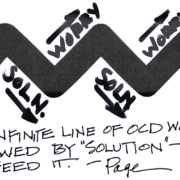I get a lot of requests for hypnosis, so today I want to share my personal philosophy about its therapeutic use. Generally, it is best used for an activity or thought you have no conscious control over. In other words, it just happens. Examples include cravings, insomnia, migraines, and panic. It has been used successfully in treating IBS, pain control, and boosting the immune system during chemotherapy. I consider it to be one type of intervention best used in conjunction with an understanding of other emotional and behavioral issues you might be experiencing. Here is a picture of what it is not: a magic wand.

Hypnosis is a completely natural state people enter several times a day. They just don’t call it that. And clinical hypnosis is a way to direct that state onto an area you want to place your focus. It works well as an adjunct treatment for most people, but not everybody. Some people really do find it difficult to trust enough to reduce their focus on self-control. When this is the case, we can try again later, or agree it is not the intervention for you. And I never do hypnosis with an individual I have not educated in its use, and who has not requested it.
In addition, I will not agree to use it for smoking cessation or addiction, for personal reasons. I also will not agree to do just one session with a client. Hypnosis is best used when there is some understanding in place about a person’s life and what is troubling them.
All of that being said, there are a number of pervasive myths that persist about its use. Let’s look at the biggies.
1. Hypnosis is about being controlled.
Nonsense. No one likes to be controlled. I think this particular myth resulted from the “old style” approach used and popularized by stage shows and old, kitschy movies. This is the kind where some charismatic operator commands you to “Look into my eyes…”
In reality…
You actually have more control and are more intentionally focused on your goal when doing inner work. My approach is the “new style” which means it is collaborative (you set the therapeutic goal) and open, and never pushes you to places you don’t want to go. And it is not the same as guided imagery or progressive relaxation, and although both can be helpful techniques, they don’t lead to solutions.
2. I’m not hypnotizable.
Again, this is nonsense. Hypnosis is a totally natural state that most people go in and out of several times a day.
And…
Almost anyone can enter the hypnotic state easily, with the exceptions of the truly mentally subnormal, very young children, and of course those under the influence of hard drugs or alcohol. You enter this state frequently, but you don’t call it hypnosis.
Examples:
When you drive a familiar route and get to your destination without even realizing it, when you get lost in a good book and completely forget about the passage of time (which is a hallmark of trance), or engage in a hobby that truly absorbs you–those are all forms of hypnosis. Hypnosis is why sponsors place all those expensive ads in the middle of the Super Bowl. You are already in trance, and easily receive the message to love a certain beer because the horses are so cool.
3. People who can enter hypnosis are weak and easy to manipulate.
Actually, it requires substantial intelligence and awareness to move into an altered state. It creates a heightened state of focus that allows non-conscious solutions to surface. Many people arrive at hypnosis as a last ditch effort to change, and then wish they had discovered it much, much sooner. All that you need is within you.
And finally….
4. What is hypnosis best used for in a therapeutic setting?
Things that are NOT under your direct, conscious control, such as panic, migraines, pain control, or boosting the immune system during chemotherapy. These are problems that interfere with your daily life, and often prevent you from doing what you want, even at the expense of family relationships and employment. It is not a parlor game.
Hypnosis, or focused inner work as I call it, is a reliable and safe therapeutic modality which is centuries old and is recognized by many branches of orthodox medicine as a valuable alternative to drugs, to accelerate healing, and to help combat pain. While it is not a panacea for all issues, and is simply one tool among many, clinical hypnosis may help you find the solution that is already within you.
If you are ready for some change, give me a call or shoot me an email. I am in your neighborhood and ready to help.
Resources: Role of Hypnosis in Chronic Pain, Hypnosis in Contemporary Medicine, Hypnosis Today










